 |
 |
News |
|
 |
| |
|
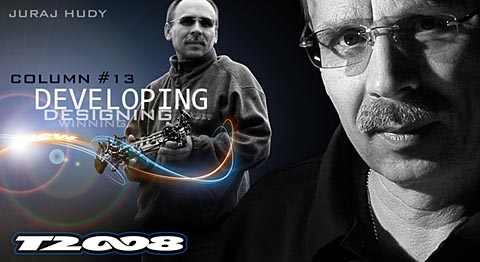
(click to enlarge) |
|
|
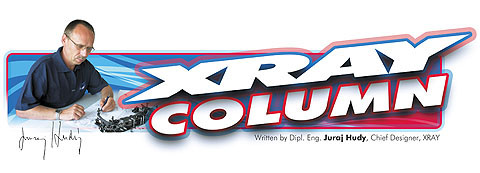
|
|
|
|
One of the major dilemmas that every manufacturer faces is âśWhen is it time for new version of our product?âť This type of dilemma is not exclusive to the R/C industry but is valid throughout ALL industries⦠whether you design and manufacture mobile phones, full size cars, or model cars. It is almost alchemy to find the right time to introduce a new model, and the rule of thumb is that whatever you do, there will always be a portion of the customer base that will be unhappy or dissatisfied⦠as they say it is just not possible to keep everybody happy.
Being a model car manufacturer, my job is to keep as many of our customers as happy as possible, and as such we face the same dilemma every year⦠when to release a new version of our very successful electric touring car line.
The T2â™007 was released in October 2006 and continued its very successful performance during the entire 2007 season... and most importantly, most customers were very happy with the car. The results of the T2â™007 were very good but of course as with all other models we continue the development, testing new things and ideas. I was so very happy with the T2â™007 Foam-Spec Edition as it won almost every race and the car was also very fast on rubber tires, but I was not so satisfied with the fact that for every different track we needed to fine-tune the set-up as the car was super sensitive to changing track conditions (especially traction changes). With a 6-cell battery pack the T2â™007 had good balance, but with the new
European rule of 5-cell packs it made the car more difficult to handle as it got even more sensitive. Therefore my goal was to bring the T2 platform to the same level as we had achieved with the NT1... a car that you can just put on any track with a basic set-up and be super quick from Lap 1 onwards. |
|
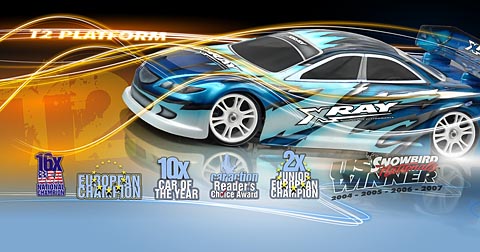
(click to enlarge) |
|
|
|
With the next development of the T2 platform we set our main goals as follows:
1. Improve side-to-side balance
2. Improve front-to-rear balance and weight distribution
3. Improve forward traction
4. Increase cornering speed
5. Make the car easier to drive
6. Decrease the overall weight
7. Decrease the weight of rotating parts
8. Optimize the drivetrain
9. Multi-Flex™ ⓠsetting chassis stiffness
10. Optimize the kits for specific foam & rubber tire conditions
Before we started with the testing and development, we first built very demanding and difficult tracks at our in-house indoor track. Of course we did the same for outdoor testing but not as much as indoors, as the weather this year was changing very rapidly and as such the outdoor track conditions were changing too fast... a good recipe for bad testing. At our indoor track we have a special environmental control system that keeps conditions very stable, and as such we could run from morning â�til night under the same track conditions, thus assuring objective results.
We built the track on asphalt as well carpet to ensure comparative testing. To increase the traction of the asphalt track we applied âśsugar waterâť on the asphalt, and with the fairly new asphalt (medium-melted grains of asphalt rolled perfectly flat) provided very unique traction⦠every minor change was very noticeable and easy to feel. We set up the track to include high-speed parts followed by sweepers, a few 180° corners, as well as a few fluid fast corners, long chicanes and a very aggressive triple chicane where the side-by-side balance was perfectly examined. |
|
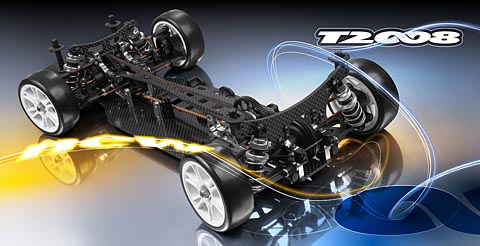
(click to enlarge) |
|
|
|
Task #1 â“ Improving the side-to-side balance
To improve the balance with 5 cells we moved the batteryâ™s counterweight (namely the motor) to as close to the centerline of the chassis as possible which helped the balance and weight distribution. To be able to move the motor toward the centerline required changes to the position of the middle pulleys, and then also the main large spur gear was placed symmetrically in between the pulleys which transfers power to the front and rear drivetrains. With this new position it also allowed us to position the servo saver exactly in the centerline of the chassis. While testing on asphalt and carpet tracks, this configuration has proven to be a dramatic improvement especially in chicanes and in direction changes.
Task #2 - Improving front-to-rear balance and weight distribution
To achieve the desired front-to-rear balance required nothing at all⦠that is, if designing several different chassis with different batteries and bulkheads placements can be called âśnothingâť! With the new European rule of 5 cells, we had to forget about what we had learned over the years with 6-cell front-to-rear balance; we had to start from Square 1 and learn and test and examine what combination worked best. We did a lot of testing not only at our tracks but at many other tracks including several periods of testing in France at the European Championship track. Only after several months of testing we decided upon the best optimal solution that seemed to work very well at all the tracks where we tested.
Task #3 - Improving forward traction
I felt that the carâ™s on-throttle speed out of corners was not exactly what we wanted, and there was still potential for improvement. I especially focused on the effectiveness of the drivetrain power transfer characteristics to the wheels (diff, solid axle, one-way diff). We did so much testing that it would take another entire column to describe all, but in a nutshell we tested different positions of the rear diff placements with respect to the motor, and afterwards to the drive to the wheels⦠then we repeated this to examine the front diff. As a final solution we found that forward traction has improved as we moved the rear diff more towards the rear, requiring the use of a new longer rear belt. |
|
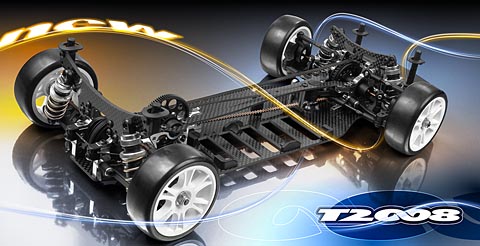
(click to enlarge) |
|
|
|
Task #4 - Increasing cornering speed
The single servo saver has worked very well for us over the years, and with all the Ackermann positions we had I was sure that they are perfect and no up for changes. But I knew we needed to change something to improve cornering speed as this was one of the main areas we were behind the competition. The cornering speed depends heavily on the suspension geometry as well as the hardness of the suspension parts, chassis & top deck stiffness. However, we had to take into consideration that cornering speed on foam tires (high traction) is vastly different than cornering speed on rubber tires (low traction). As such we worked mainly on the length of the arms and their positions with respect to the centerline of the chassis. To make the life of regular drivers easier we decided to pursue one lower shock mounting position; to that end we handed out several different arms with different shock mounting positions to team drivers to collect their feedback from racing at their tracks. From all the collected data we were able to collect we easily found the optimum lower mounting position that worked well at all the different tracks. Drawing on all of our experience from previous T1 / T2 cars, it was a â�no-brainerâ™ to go with harder suspension parts for high-traction foam tires, and more flexible suspension parts for use with low-traction rubber tires.
Task #5 - Making the car easier to drive
This is one of the most common issues faced⦠making the car easy to drive. Top drivers need the car to be very reactive and with their above-average racing skills they can control understeering/oversteering with a very precise set-up which makes the car super sensitive. Looking at their runs you have the feeling that their cars are âśsuper dialedâť but sometimes the opposite is the truth. Any time I try a car from some top driver I am just not able to drive one lap without a mistake. Martin can drive and handle a sensitive car and be fast with it, but myself I just need a car that is super easy to drive... at my age it takes more time for the brain signals to go from the brain to the fingers⦠seemingly MUCH longer than for younger people. So anytime I design a car I try to make it fast for top drivers so they can win a race, but at the same time I need the car to be easy to drive for myself so average drivers can handle the car well and have fun and be fast at the same time. So a combination of side-by-side testing of Martin and myself gives the perfect output as if something works well for Martin and at the same time for myself, I know it is a great improvement! The design of an easy-to-drive car does not depend on one or two parts, but is the overall result of the geometry and parts of the car. Still, some of the most important factors that influence the handling are the skeleton of the car â“ the chassis and top deck mounted to the bulkheads â“ and of course a low CG, proper weight distribution, shocks, etc. Over the months I believe we tested almost 20 different skeletons and we raced with Martin every evening after work until the wee hours. With over 5000 laps completed myself and almost another 5000 laps completed by Martin â“ some better than others â“ we gathered all of our experience with the different parts and brainstormed. As usual, we kept our R&D and prototype production extremely busy, and almost every day we had another idea or needed to modify this or that part to try it differently. With the in-house production we put our ideas into the âśGreat Machineâť and the next evening we had the part in the car and tested. This has definitely helped to reduce testing and development time to a minimum. To improve the CG we lowered the shock towers and as such made shorter shocks, and to make the car easier to drive we developed all-new line of springs especially designed for rubber tire racing. |
|
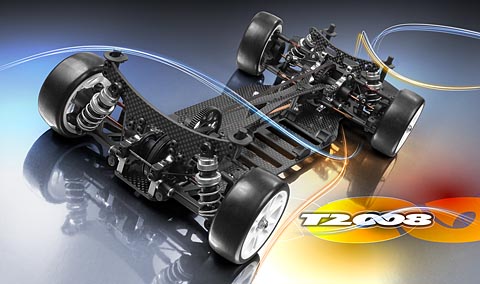
(click to enlarge) |
|
|
|
Task #6 - Decreasing the overall weight
Since the new 5-cell rules allow for lower weight, we had to do our homework to make the parts as light as possible compromising strength. Since the suspension parts are already as light as possible, we turned our focus on the bulkheads to see where weight could be saved. The result is super-lightweight bulkheads with very narrow walls which could only be achieved using high-tensile 7075 T6 aluminum. Despite having super-thin walls, the bulkheads are still immensely strong and hold the carâ™s skeleton together very well even in seriously strong crashes.
Task #7 - Decreasing the weight of rotating parts
For overall performance, reducing the rotating weight of parts is paramount. We concentrated our efforts on reducing the rotating mass of the front axle, due largely in part to todayâ™s super-strong power plants being used in cars with rubber tires and solid front axles. I originally proposed to make the entire solid axle and outdrives from Delrin™, but during testing some problems arose as the Delrin™ outdrives were breaking. I thought that the ultimate solution would be to forget about the traditional solid axle and come up with something completely unique⦠in short I would need to change the whole concept of the solid axle. I spent a lot of time thinking about what to change on the solid axle, but whatever ideas I had I just as quickly dismissed them as they would solve one problem but other problems would arise somewhere else. The smartest solutions are always the simplest⦠so I resigned myself to putting away the standard solid axle for a while⦠then when I came back I looked at it with a clear mind. And the solution came very easily. The solid axle with pulley is made from one piece so to reduce the weight we need to mould as one pieceâ¦but to keep the servicing costs as low as possible I have decided to make the outdrives replaceable. With this design concept we have designed the pulley and the body molded as a single composite part, with separate composite outdrives mounted to the solid axle. This concept not only increases the life of the outdrives, but it makes the engagement super smooth. To ensure that the outdrives will not break we have made the outdrives robust enough to ensure that the slot will not open or break. The first prototypes confirmed that the concept is very good but I was not happy with the lifespan so we created a different composite mixture which will remain very strong while having significantly-improved wear resistance. With a few dozen different mixtures we had no other choice than to make long term tests to find the wear rate of each and in the end we had a few favorites with similar lifespan/ performance specs⦠out of which we decided upon the one most easy to inject. During the tests we noticed that the steering is much smoother than with the previous solid axle and the drivetrain seems more efficient as well. With very positive results of the composite solid axle, I thought that a ball differential of the same style would be an improvement as well, and will not only lighten the drivetrain but will reduce service costs. I expect it will have a positive influence on the handling and performance of the car as well. |
|
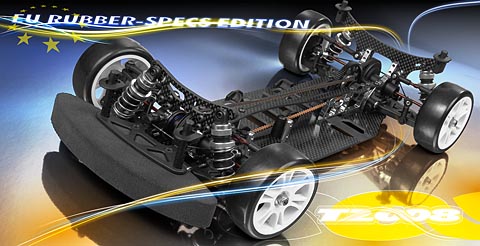
(click to enlarge) |
|
|
|
Task #8 â“ Optimizing the drivetrain
One of the areas that could stand some improvement is the drivetrain⦠how power from the motor gets to the tires. Analyzing and constantly thinking about the drivetrain ratios⦠reviewing the theory of rolling of the teeth on pulleys⦠and making a lot of calculations⦠I still thought that foam tires and rubber tires are just so different that the current ratio simply could not be the best for both racing conditions. If we even just consider the different diameters of rubber vs. foam tires, the standard âśone approachâť drivetrain ratio is not optimum and could definitely benefit from some ingenuity. To avoid blind testing we started from what has worked â“ which was our best performance on foam tires â“ so I expected that we needed to focus on the ratios for rubber tires. The T2â™007 features 34T diff pulleys and 20T middle pulleys, giving a ratio of 1.7. This concept is effective both in theory but also in practice from the point of rolling, because as the pulley is larger the âśless-kinkingâť wrapping of the belt results in a freer and more efficient drivetrain. But at this 1.7 gear ratio it is very stiff which I expected was the source of problems when running with rubber tires⦠acceleration is not very smooth like with a higher ratio. BUT⦠on the other hand it is advantageous off-power and into corner because it gives more steering. So I knew we needed to find some compromise. We made several different prototypes and found that we still liked the original ratio when using foam tires, but for rubber tires it worked out that a 38T diff pulley and 16T middle pulley gave better performance. To optimize the drivetrain efficiency we also tested with diff heights and drive shafts lengths and despite small differences we experienced a significant influence on the handling characteristics. After long-term testing we decided to incorporate the diff height adjustment into the bulkheads and provide two different drive shaft lengths. When running rubber tires (which typically have larger diameters than foam tires), longer drive shafts transfer power to the tires better as it allows the drive shafts to be placed toward the centerline, which helps to stabilize the car.
Task #9 ⓠMulti-Flex™ ⓠsetting chassis stiffness
Chassis flex is again one of the most important features that influences performance and handling of the car. The T2 & T2â™007 revolutionized the RC world with the introduction of Multi-Flex™ settings for different racing conditions. For the T2â™008 we knew we need to incorporate the optimum flex for each of the different foam- and rubber-spec editions, but still retaining the possibility to adjust it by adding or removing screws from the bottom of the chassis or from the top of the top deck. For rubber-tire cars to gain additional flex, we added a reinforcement leg on the bottom front bulkheads and to gain more flex the screw from the bottom may be removed. For foam-tire cars we continue to use the extra-thick chassis and top deck mounts which connect the top deck and chassis together on the sides, thus creating a super solid platform which is a âśmust haveâť for high-traction foam tires. The flex on carpet and asphalt are completely different and to make it easy for average drivers we will summarize our long-term testing into the basic set-up sheets for all different racing conditions. |
|
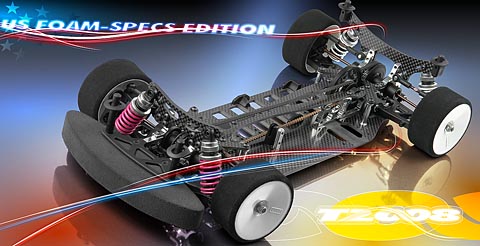
(click to enlarge) |
|
|
|
Task #10 - Optimize the kits for specific foam & rubber tire conditions
After several years of experience, testing and development of our T1 and T2 platforms it is a definitive fact that conditions for rubber and foam tires are completely different, and as such the construction of the car has to be adapted to those specific conditions. While working on the new car I kept in mind that our goal was to provide the customer with a car for his/her particular racing condition that s/he would just build it out of the box and be able to win any race. The whole long-term development was highlighted in these three words: Revolution, Evolution & Optimization. The optimization was in the constant thinking we have kept in mind as over the years of being an RC car designer I have learned that I need to get into thinking of regular RC customers who do not have all the knowledge and experience about set-up, flex settings and all the ultra-fine set-up tricks that pro drivers do. Such a customer buys the product to have fun and be competitive with it. The Optimization of the T2â™008 refers to the fact that you do not have to be a set-up expert to win your race, you just need to buy the proper version of the T2â™008⦠either for foam or rubber tires, 5 or 6 cells⦠and building it based on the basic set-up you will have the car that is supremely capable of winning any race. As such I can honestly say that we never had a more optimized car as we do now and I am convinced that customers will not only appreciate it but they will love the handling and performance right out of the box.
Now the typical dilemma for us was once again â“ when to get the new T2â™008 to the customers. I knew that we will hear the arguments âśXRAY brings out a new car after one year againâť but at the same time we all must realize that development in this market has been blindingly fast over the last year, and with the new rules for 5-cell and 6-cell the current platform was falling behind in competitive edge. Being in a highly competitive world, it is our mission to offer customers the best performing product. As such I am convinced that the optimized car is a marked improvement for customers and they will appreciate that the new car will be to their benefit⦠whether having better performance, or less service costs, or an optimized platform with all parts needed for particular racing conditions. |
|
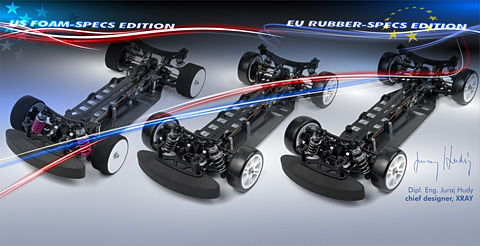
(click to enlarge) |
|
|
|
| After the great results at the European Championship where Steven Weiss TQâ™d the Euros and got the title of Vice-Champion, and also with 10 prototypes in the top 20 and 4 cars in the main final, I knew that we are correct in our decision to getting the new car to the customers for the winter season. This good decision paid off at the recent International Indoor Championship where Paul Lemieux TQâ™d and came in 2nd with the new T2â™008 in the Modified Rubber category with all the World Champions in the race. Moreover, Teemu Leino won the Modified Foam category, so there were no more doubts that both EU Rubber-Spec and US Foam-Spec editions of the T2â™008 will be the car to beat in 2008. Whether you are a National or local champion, or if you just race for fun, there is a T2â™008 for you loaded with anything you need...just add your desire to win. |
|
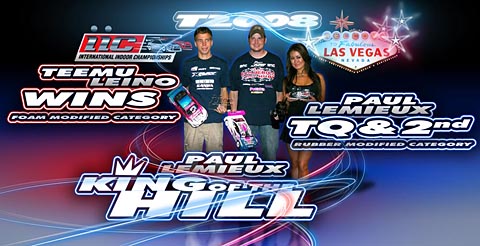
(click to enlarge) |
|
|
|
This was my column number 13 and as such I am starting to write this series of columns for the second year, every month, keeping everybody updated about the regular life of an R/C company. During the last year a lot of things have happened and changed and as such I am trying to keep everybody updated what is going on about our opinions and positions, and our short term and long term plans. Over time I have received plenty of feedback, e-mails, and even talks at races around the world where people encourage me to continue the work we have been doing and to continue to write this column. Of course I am always looking to improve things and as such I am open for any constructive criticism, new ideas and suggestions. So⦠whatever feedback you have for me or for the columns or the work we have been doing, please contact us and tell us. We are here to listen to you and to do everything possible to keep you happy and satisfied. Check our online forum where you can post your thoughts and comments. Thank you for your feedback in advance.
And last but CERTAINLY not least, thanks to everybody for the ongoing support. |
|

|
Enjoy the ride and â�til next timeâ¦
Dipl. Eng. Juraj Hudy
Chief Designer XRAY |
|
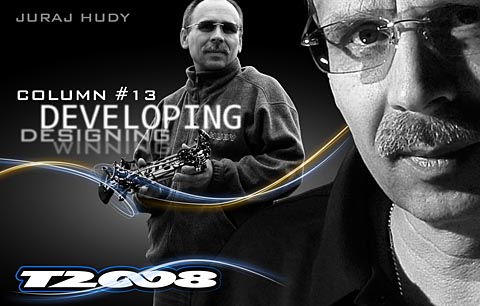
(click to enlarge) |
|
|
|
|
|























